Utilization of Secondary Raw Materials from Rice and Buckwheat Processing for the Production of Enriched Bread: Optimization of Formulation, Physicochemical and Organoleptic Properties, Structural and Mechanical Properties, and Microbiological Safety
Abstract
1. Introduction
2. Materials and Methods
2.1. Materials
2.2. Mathematical Modeling and Optimization of Recipe Composition of Bakery Products Using Rice and Buckwheat Brans
2.3. Breadmaking Process
2.4. Characterization of Doughs
2.4.1. Determination of Dough Rheological Properties
2.4.2. Determination of Physical and Chemical Parameters of the Dough
2.5. Characterization of Bread
2.5.1. Determination of Physicochemical Parameters
2.5.2. Determination of Organoleptic Parameters
2.5.3. Determination of Structural–Mechanical Properties
2.5.4. Microbiological Safety
2.5.5. Chemical Composition and Nutritional Value of Enriched Bread
2.6. Statistical Analysis of the Data
3. Results
3.1. Optimization of Recipe Composition of Bakery Products Using Rice and Buckwheat Brans
9.89308x22 + 10.7751x23
− 0.46846x23
3.2. Dough Properties
3.3. Physicochemical and Sensory Properties of Bread
3.4. Structural and Mechanical Properties of Bread
3.5. Microbiological Safety of Bread
3.6. Study of Chemical Composition and Nutritional Value of Enriched Bread
4. Conclusions
5. Patents
- Esembek Madina Zhanibekkyzy. Tarabaev Baltash Karimovich. Kuznetsova Lina Ivanovna. Omaraliyeva Aigul Makhmutovna. Botbayeva Zhanar Turlybekovna. Method of preparing a leaven for producing bread. For utility model No. 7716. filed 30 October 2022 and issued on 06 January 2023.
- Esembek Madina Zhanibekkyzy. Tarabaev Baltash Karimovich. Kuznetsova Lina Ivanovna. Omaraliyeva Aigul Makhmutovna. Botbayeva Zhanar Turlybekovna. Brewed wheat bread production method. For utility model No. 7736. filed on 16 November 2022 and issued on 13 January 2023.
Author Contributions
Funding
Institutional Review Board Statement
Informed Consent Statement
Data Availability Statement
Conflicts of Interest
References
- Verni, M.; Rizzello, C.G.; Coda, R. Fermentation biotechnology applied to cereal industry by-products: Nutritional and functional insights. Front. Nutr. 2019, 6, 42. [Google Scholar] [CrossRef] [PubMed]
- Tan, B.L.; Norhaizan, M.E.; Chan, L.C. Rice bran: From waste to nutritious food ingredients. Nutrients 2023, 15, 2503. [Google Scholar] [CrossRef]
- Fărcaș, A.; Drețcanu, G.; Pop, T.D.; Enaru, B.; Socaci, S.; Diaconeasa, Z. Cereal processing by-products as rich sources of phenolic compounds and their potential bioactivities. Nutrients 2021, 13, 3934. [Google Scholar] [CrossRef] [PubMed]
- Nogala-Kałucka, M.; Kawka, A.; Dwiecki, K.; Siger, A. Evaluation of bioactive compounds in cereals. Study of wheat, barley, oat and selected grain products. Acta Sci. Pol. Technol. Aliment. 2020, 19, 405–423. [Google Scholar]
- Vitol, I.S.; Igoryanova, N.A.; Meleshkina, E.P. Bioconversion of secondary products of processing of grain cereals crops. Food Syst. 2019, 2, 18–24. [Google Scholar] [CrossRef]
- Cheng, W.; Sun, Y.; Fan, M.; Li, Y.; Wang, L.; Qian, H. Wheat bran. as the resource of dietary fiber: A review. Crit. Rev. Food Sci. Nutr. 2022, 62, 7269–7281. [Google Scholar] [CrossRef]
- Budhwar, S.; Chakraborty, M.; Sethi, K.; Chatterjee, A. Antidiabetic properties of rice and wheat bran—A review. J. Food Biochem. 2020, 44, e13424. [Google Scholar] [CrossRef] [PubMed]
- Yefremova, S.; Kablanbekov, A.; Satbaev, B.; Zharmenov, A. Rice Husk-Based Adsorbents for Removal of Metals from Aqueous Solutions. Materials 2023, 16, 7353. [Google Scholar] [CrossRef]
- Spaggiari, M.; Dall’Asta, C.; Galaverna, G.; del Castillo Bilbao, M.D. Rice bran by-product: From valorization strategies to nutritional perspectives. Foods 2021, 10, 85. [Google Scholar] [CrossRef]
- Espinales, C.; Cuesta, A.; Tapia, J.; Palacios-Ponce, S.; Peñas, E.; Martínez-Villaluenga, C.; Espinoza, A.; Cáceres, P.J. The effect of stabilized rice bran addition on physicochemical, sensory, and techno-functional properties of bread. Foods 2022, 11, 3328. [Google Scholar] [CrossRef]
- Wu, D.-T.; Li, W.-X.; Wan, J.-J.; Hu, Y.-C.; Gan, R.-Y.; Zou, L. A comprehensive review of pea (Pisum sativum L.): Chemical composition, processing, health benefits and food applications. Foods 2023, 12, 2527. [Google Scholar] [CrossRef]
- Noda, T.; Ishiguro, K.; Suzuki, T.; Morishita, T. Tartary buckwheat bran: A review of its chemical composition, processing methods and food uses. Plants 2023, 12, 1965. [Google Scholar] [CrossRef] [PubMed]
- Zhang, S.; Chen, S.; Geng, S.; Liu, C.; Ma, H.; Liu, B. Effects of tartary buckwheat bran flour on dough properties and quality of steamed bread. Foods 2021, 10, 2052. [Google Scholar] [CrossRef]
- Gul, K.; Yousuf, B.; Singh, A.; Singh, P.; Wani, A.A. Rice bran: Nutritional values and its emerging potential for development of functional food—A review. Bioact. Carbohydr. Diet. Fibre 2015, 6, 24–30. [Google Scholar] [CrossRef]
- Liu, B.; Zhu, Y. Extraction of flavonoids from flavonoid-rich parts in tartary buckwheat and identification of the main flavonoids. J. Food Eng. 2007, 78, 584–587. [Google Scholar] [CrossRef]
- Luithui, Y.; Baghya Nisha, R.; Meera, M. Cereal by-products as an important functional ingredient: Effect of processing. J. Food Sci. Technol. 2019, 56, 1–11. [Google Scholar] [CrossRef]
- Alves, J.B.; Rodrigues, M.H.P.; Duarte, F.A.; Furlong, E.B.; Christ-Ribeiro, A. Rice Bran and Its Potential To Complement the Nutritional Needs of Children and Elderly. Plant Foods Hum. Nutr. 2023, 78, 86–92. [Google Scholar] [CrossRef]
- Rasulov, M. Problems of organization of rice cluster in Kazakhstan. Bull. Karaganda Univ. 2006, 1, 89. [Google Scholar]
- Zamaratskaia, G.; Gerhardt, K.; Knicky, M.; Wendin, K. Buckwheat: An underutilized crop with attractive sensory qualities and health benefits. Crit. Rev. Food Sci. Nutr. 2023, 3, 1–16. [Google Scholar] [CrossRef]
- Chettry, U.; Chrungoo, N.K. Beyond the cereal box: Breeding buckwheat as a strategic crop for human nutrition. Plant Foods Hum. Nutr. 2021, 76, 399–409. [Google Scholar] [CrossRef]
- Yang, J.; Luo, Z.; Liu, F.; Han, L.; He, C.; Wang, M. Nanocellulose Prepared from Buckwheat Bran: Physicochemical Characterization. Cytotoxicity Evaluation. and Inhibition Effect on Fat Digestion and Absorption. J. Agric. Food Chem. 2022, 70, 11603–11612. [Google Scholar] [CrossRef]
- Yu, Y.; Liang, G.; Wang, H. Interaction mechanism of flavonoids and Tartary buckwheat bran protein: A fluorescence spectroscopic and 3D-QSAR study. Food Res. Int. 2022, 160, 111669. [Google Scholar] [CrossRef] [PubMed]
- Esembek, M.; Tarabayev, B.; Omaralieva, A.; Botbaeva, Z.; Kakimov, M. Research of secondary raw materials of grain processing for use in bread production. J. Almaty Technol. Univ. 2022, 2, 29–35. [Google Scholar] [CrossRef]
- Nikiforova, T.A.; Hon, I.A. Effect of buckwheat flour on the preservation of bread freshness. Khleboprodukty 2017, 6, 38–39. [Google Scholar]
- Loskutov, I.G.; Khlestkina, E.K. Wheat, barley and oat breeding for health benefit components in grain. Plants 2021, 10, 86. [Google Scholar] [CrossRef] [PubMed]
- Kumar, K.; Chauhan, D.; Kumar, S.; Sharma, M.; Kaur, R.; Vyas, P. Barley: A potential source of functional food ingredients. In Proceedings of the Conference: National Seminar on Technological Interventions in Food Processing and Preservation, Jaipur, India, 6–8 November 2017. [Google Scholar]
- Martínez-Villaluenga, C.; Peñas, E. Health benefits of oat: Current evidence and molecular mechanisms. Curr. Opin. Food Sci. 2017, 14, 26–31. [Google Scholar] [CrossRef]
- Bhullar, N.K.; Gruissem, W. Nutritional enhancement of rice for human health: The contribution of biotechnology. Biotechnol. Adv. 2013, 31, 50–57. [Google Scholar] [CrossRef]
- Boldina, A.A.; Sokol, N.V.; Sanzharovskaya, N.S. The use of rice bran in the technology of bread of functional purpose. Tech. Technol. Food Prod. 2017, 47, 21–26. [Google Scholar]
- Saeed, S.M.; Arif, S.; Ahmed, M.M.; Ali, R.; Shih, F.F. Influence of rice bran on rheological properties of dough and in the new product development. J. Food Sci. Technol.-Mysore 2009, 46, 62–65. [Google Scholar]
- Alekhina, N.N.; Ponomareva, E.A.; Lukin, S.I.; Smirnykh, A.A. Grain bread with buckwheat bran flour for a healthy diet. J. Eng. Appl. Sci. 2016, 11, 2623–2627. [Google Scholar]
- Yessembek, M.Z.; Tarabayev, B.K.; Omaralieva, A.M.; Botbaeva, Z.T.; Kakimov, M.M. The influence of secondary raw materials of grain processing on the rheological properties of the dough. J. Almaty Technol. Univ. 2024, 144, 5–14. [Google Scholar] [CrossRef]
- Tolstoguzov, V.B.; Lemisova, L.V.; Chimirov, J.U.I.; Braudo, E.E.; Tsyrjapkin, V.A.; Volnova, A.I.; Kozmina, E.P. Artificial groats from rice-processing by-products. Food/Nahrung 1980, 24, 951–962. [Google Scholar] [CrossRef]
- Ryabukha, N.P. Development and evaluation of consumer properties of a lipid-protein additive based on rice flour for bakery products. Dis. Candidate Tech. Sci. 2005, 149. [Google Scholar]
- Zhmanchinskaya, E.O.; Zhirov, D.K.; Merenkova, S.P. Scientific substantiation of resource-saving technologies for the manufacture of bakery products for functional purposes. In Proceedings of the Ural Branch of the Russian Academy of Sciences “Problems of Mechanics and Materials Science”; Ural Branch of the Russian Academy of Sciences: Yekaterinburg, Russia, 2016; pp. 152–158. [Google Scholar]
- Sapwarobol, S.; Saphyakhajorn, W.; Astina, J. Biological functions and activities of rice bran as a functional ingredient: A review. Nutr. Metab. Insights 2021, 14, 11786388211058559. [Google Scholar] [CrossRef]
- Sharif, M.K.; Butt, M.S.; Anjum, F.M.; Khan, S.H. Rice bran: A novel functional ingredient. Crit. Rev. Food Sci. Nutr. 2014, 54, 807–816. [Google Scholar] [CrossRef] [PubMed]
- Sohail, M.; Rakha, A.; Butt, M.S.; Iqbal, M.J.; Rashid, S. Rice bran nutraceutics: A comprehensive review. Crit. Rev. Food Sci. Nutr. 2017, 57, 3771–3780. [Google Scholar] [CrossRef]
- Badamshina, E.; Leonova, S.; Gareeva, I.; Nikulina, N.S.; Koschina, E. The use of flour from germinated buckwheat in bread recipes. In Proceedings of the BIO Web of Conferences, Jember, Indonesia, 12–13 September 2023; p. 01009. [Google Scholar]
- Berezkina, A.D. Microbiological aspects of the formation and change of the quality of bread and bakery products in the process of production and storage. Eurasian Sci. Assoc. 2018, 12, 153–156. [Google Scholar]
- Kakimov, M.; Mursalykova, M.; Gajdzik, B.; Wolniak, R.; Kokayeva, G.; Bembenek, M. Optimal Ways of Safflower Oil Production with Improvement of Press Equipment. Foods 2024, 13, 1909. [Google Scholar] [CrossRef] [PubMed]
- Utarova, N.; Kakimov, M.; Gajdzik, B.; Wolniak, R.; Nurtayeva, A.; Yeraliyeva, S.; Bembenek, M. Development of Gluten-Free Bread Production Technology with Enhanced Nutritional Value in the Context of Kazakhstan. Foods 2024, 13, 271. [Google Scholar] [CrossRef] [PubMed]
- Dudnikova, D. Problems of potato disease of bread in Kazakhstan. Bread Prod. 2001, 11, 23–26. [Google Scholar]
- Chizhikova, O.G.; Korshenko, L.O. Bread and Bakery Products Production Technology: Textbook for Secondary Vocational Education, 3rd ed.; Yurait Publishing House: Moscow, Russia, 2024; p. 252. [Google Scholar]
- Esembek, M.; Tarabaev, B.; Kuznetsova, L.; Omaraliyeva, A.; Botbayeva, Z. Method of Preparing a Leaven for Producing Bread. Republic of. Kazakhstan Patent No. 7716, 6 January 2023. [Google Scholar]
- Esembek, M.; Tarabaev, B.; Kuznetsova, L.; Omaraliyeva, A.; Botbayeva, Z. Brewed Wheat Bread Production Method. Republic of Kazakhstan Patent No. 7736, 13 January 2023. [Google Scholar]
- Kosovan, A.P.; Polandova, R.D.; Kostyuchenko, M.N. Collection of Modern Technologies of Bakery Products; State Research Institute of Baking Industry: Moscow, Russia, 2008; p. 271. [Google Scholar]
- ISO 27971:2023; Cereals and Cereal Products. Common Wheat (Triticum aestivum L.). Determination of Alveograph Properties of Dough at Constant Hydration from Commercial or Test Flours and Test Milling Methodology. ISO: Geneva, Switzerland, 2023.
- ISO 17718:2013; Wholemeal and Flour from Wheat (Triticum aestivum L.). Determination of Rheological Behaviour as a Function of Mixing and Temperature Increase. ISO: Geneva, Switzerland, 2013.
- Puckova, L.I. Laboratory Practice of Bread-Making Technology, 4th ed.; GIORD: Saint Petersburg, Russia, 2004; p. 259. [Google Scholar]
- GOST 5898-2022; Confectionery. Methods for Determination of Acidity and Alkalinity. Russian Scientific Research Institute of the Confectionery Industry. A Branch of the Federal State Budgetary Scientific Institution “V.M. Gorbatov Federal Scientific Center for Food Systems” of the Russian Academy of Sciences: Moscow, Russia, 2022.
- GOST 27669-88; Wheat Bread Flour. Method for Experimental Laboratory Breadmaking. Standartinform: Moscow, Russia, 2007.
- GOST 171-2015; Pressed Baking Yeast. Technical Conditions. Republican State Enterprise “Kazakhstan Institute of Standardization and Certification”: Minsk, Belarus, 2015.
- GOST 21094-2022; Bakery Products Methods of the Moisture Determination. Federal State Autonomous Scientific Institution “Scientific Research Institute of the Bakery Industry” (FGANU NIIHP): Moscow, Russia, 2022.
- GOST 5670-96; Bread, Rolls and Buns. Methods for Determination of Acidity. State Scientific Research Institute of the Bakery Industry: Minsk, Belarus, 2006.
- GOST 5669-96; Method for Determination of Porosity. State Scientific Research Institute of the Bakery Industry (GosNIIHP): Minsk, Belarus, 2006.
- GOST 5962-2013; Rectified ethyl Alcohol from Food Raw Materials. Technical Conditions. Developed by the State Scientific Institution “All-Russian” Scientific Research Institute of Food Biotechnology” of the Russian Agricultural Academy (GNU VNIIPBT of the Russian Agricultural Academy): Moscow, Russia, 2014.
- Koryachkina, S.Y.; Berezina, N.A.; Khmeleva, E.V. Methods of studying the properties of raw materials, semi-finished products and finished products. In Methods of Studying the Properties of Semi-Finished Bakery Products: Educational and Methodical Manual for Higher Professional Education; FGOU VPO “Gosuniversitet–UNPK”: Orel, Russia, 2011; p. 49. [Google Scholar]
- GOST 5672-2022; Bakery Products. Methods for Determination of Sugar Content. Federal State Autonomous Scientific Institution “Scientific Research Institute of the Bakery Industry” (FGANU NIIHP): Moscow, Russia, 2022.
- GOST 5667-2022; Bakery Products. Acceptance Rules, Sampling Methods, Methods for Determining Organoleptic Parameters and Mass of Products. Federal State Autonomous Scientific Institution “Scientific Research Institute of the Bakery Industry” (FGANU NIIHP): Moscow, Russia, 2022.
- Romanov, A.S.; Davydenko, N.I.; Shatnyuk, L.N. Examination of Bread and Bakery Products, Quality and Safety; Siberian University: Novosibirsk, Russia, 2005; p. 278. [Google Scholar]
- Afanasyeva, O.V. Microbiology of Bakery Production; SPbF GOSNIIHP: Saint-Petersburg, Russia, 2003; p. 220. [Google Scholar]
- Kosovan, A.P.; Polandova, R.D.; Kostyuchenko, M.N.; Volokhova, L.T.; Bykovchenko, T.V.; Dremucheva, G.F. Instructions for the Prevention of Potato Disease of Bread at Bakery Enterprises; GNU GOSNIIHP of the Russian Agricultural Academy: Moscow, Russia, 2012; p. 32. [Google Scholar]
- GOST 10846-91; Grain and Products of Its Processing. Method for Determination of Protein. Standartinform: Moscow, Russia, 2009.
- GOST 5668-2022; Bakery Products. Methods for Determination of Fat Content. Federal State Autonomous Scientific Institution “Scientific Research Institute of the Bakery Industry” (FGANU NIIHP): Moscow, Russia, 2022.
- GOST R 51636-2000; Fodder Mixed Fodder and Animal Feed Raw Stuffs. Photometric with 2.4-Dinitrophenol and Permanganate Methods for Determination of Water Soluble Carbohydrates. Standartinform: Moscow, Russia, 2020.
- GOST 31675-2012; Feeds. Methods for Determination of Crude Fibre Content with Intermediate Filtration. Standartinform: Moscow, Russia, 2014.
- GOST R 54634-2011; Functional Food Products. Method of Vitamin E Determination. Standartinform: Moscow, Russia, 2019.
- GOST 32343-2013; Feed, Compound Feed. Determination of the Content of Calcium, Copper, Iron, Magnesium, Manganese, Potassium, Sodium and Zinc by Atomic Absorption Spectrometry. Standartinform: Moscow, Russia, 2020.
- Shansharova, D. Wheat bread with the use of rice and buckwheat brans. Khleboprodukty 2010, 8, 39–41. [Google Scholar]
- Usembaeva, Z.K.; Shansharova, D.A.; Maksut, A.M. Development of the technology of wheat bread with the application of products of processing groats production. J. Almaty Technol. Univ. 2017, 3, 30–33. [Google Scholar]
- Savkina, O.; Kuznetsova, L.; Parakhina, O.; Lokachuk, M.; Pavlovskaya, E. Impact of using the developed starter culture on the quality of sourdough, dough and wheat bread. Agron. Res. 2019, 17, 1435–1451. [Google Scholar]
- Sharmanova, T.S.; Sinyavsky, Y.A.; Sharman, A.T.; Kobzhasarov, D.A.; Zhusupov, B.S.; Sharipbaeva, A.S. Norms of Physiological Energy and Nutrient Requirements for Various Population Groups of the Republic of Kazakhstan: Methodological Recommendations; Sanitary and Epidemiological Control Committee of the Ministry of Health of the Republic of Kazakhstan: Astana, Kazakhstan, 2023; p. 141.

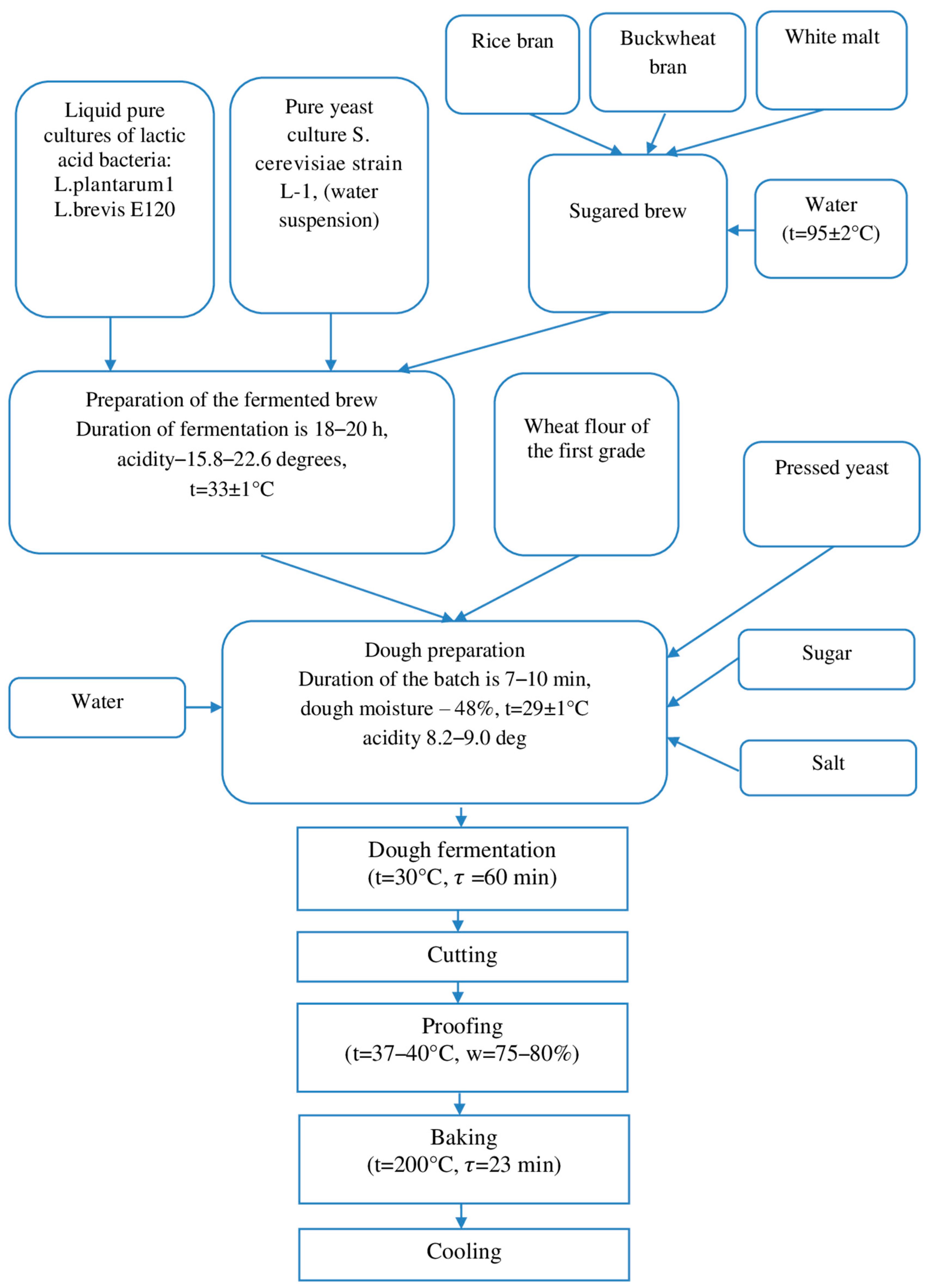

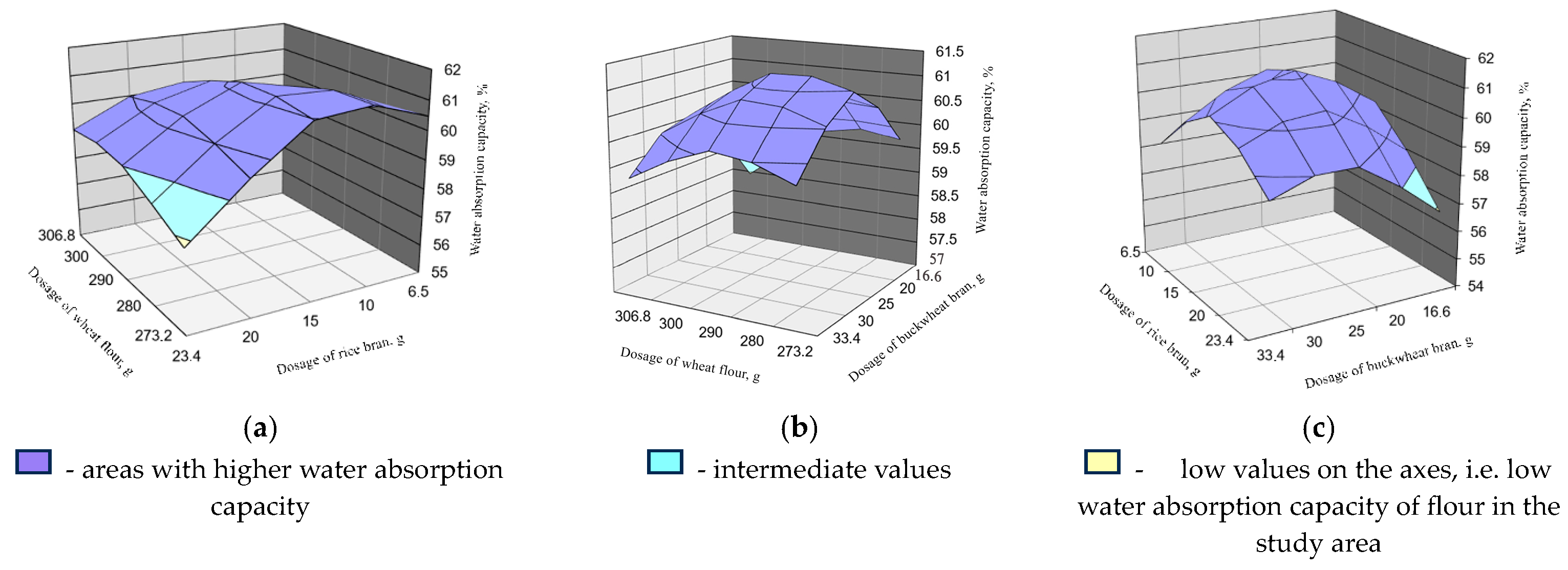


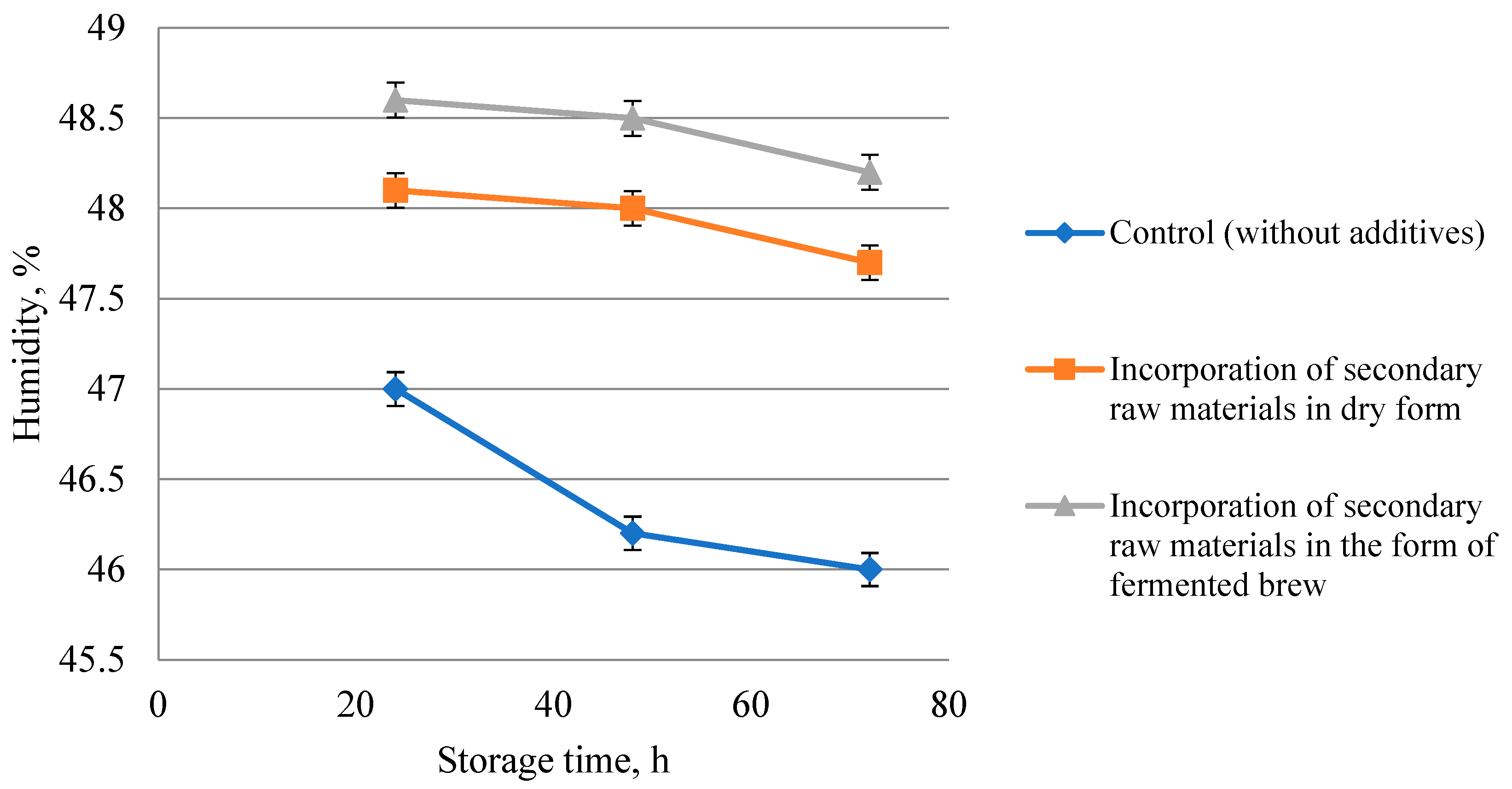
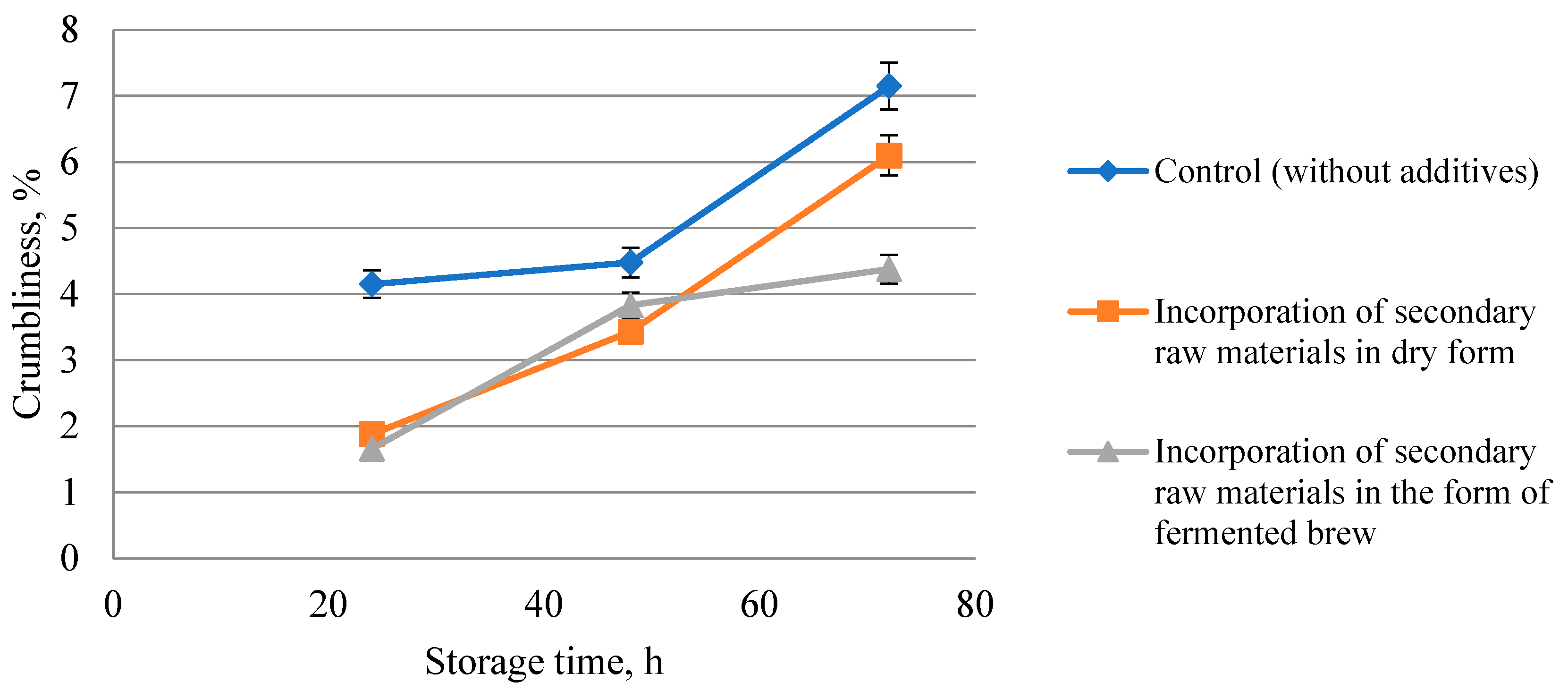
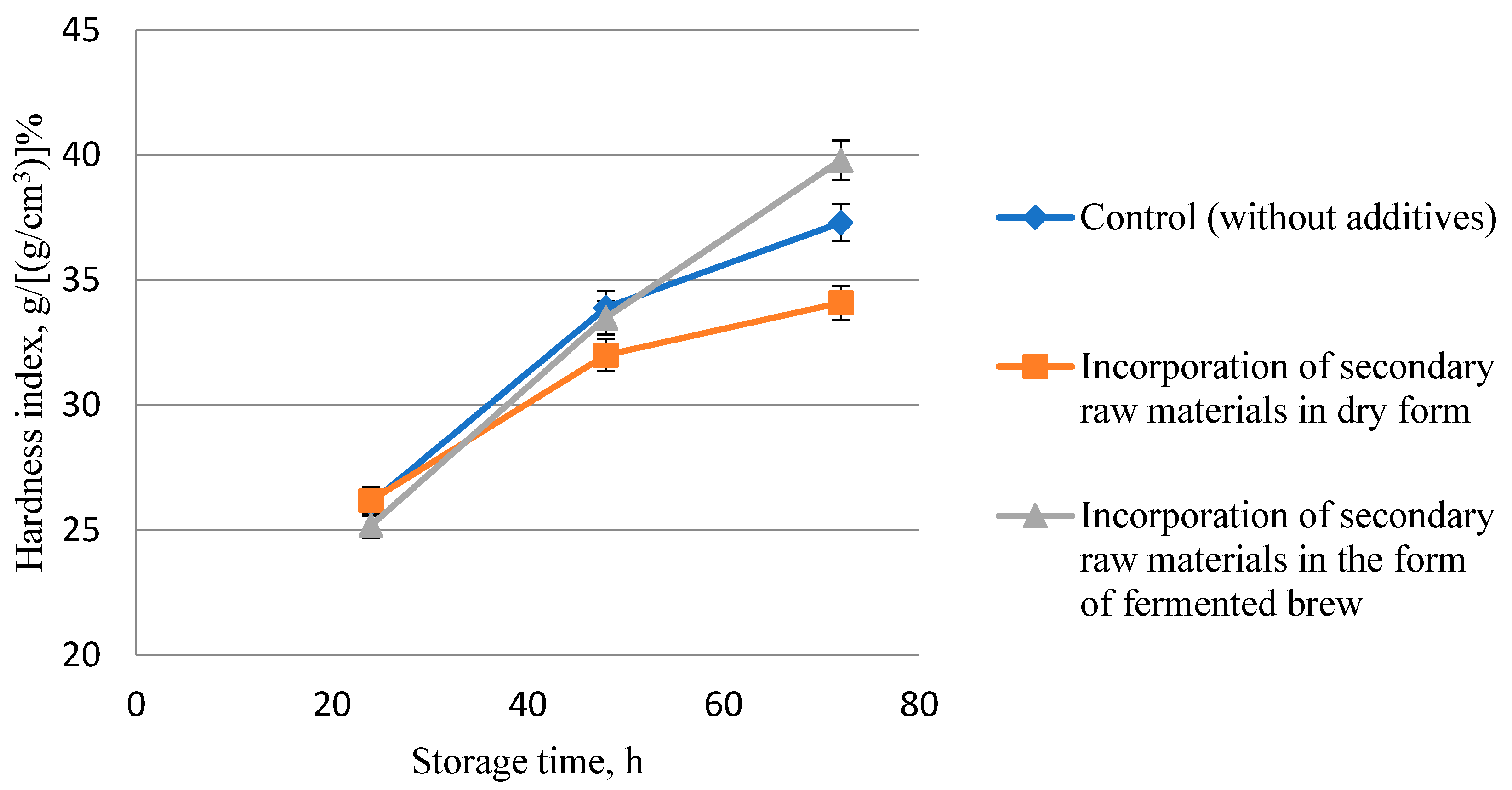
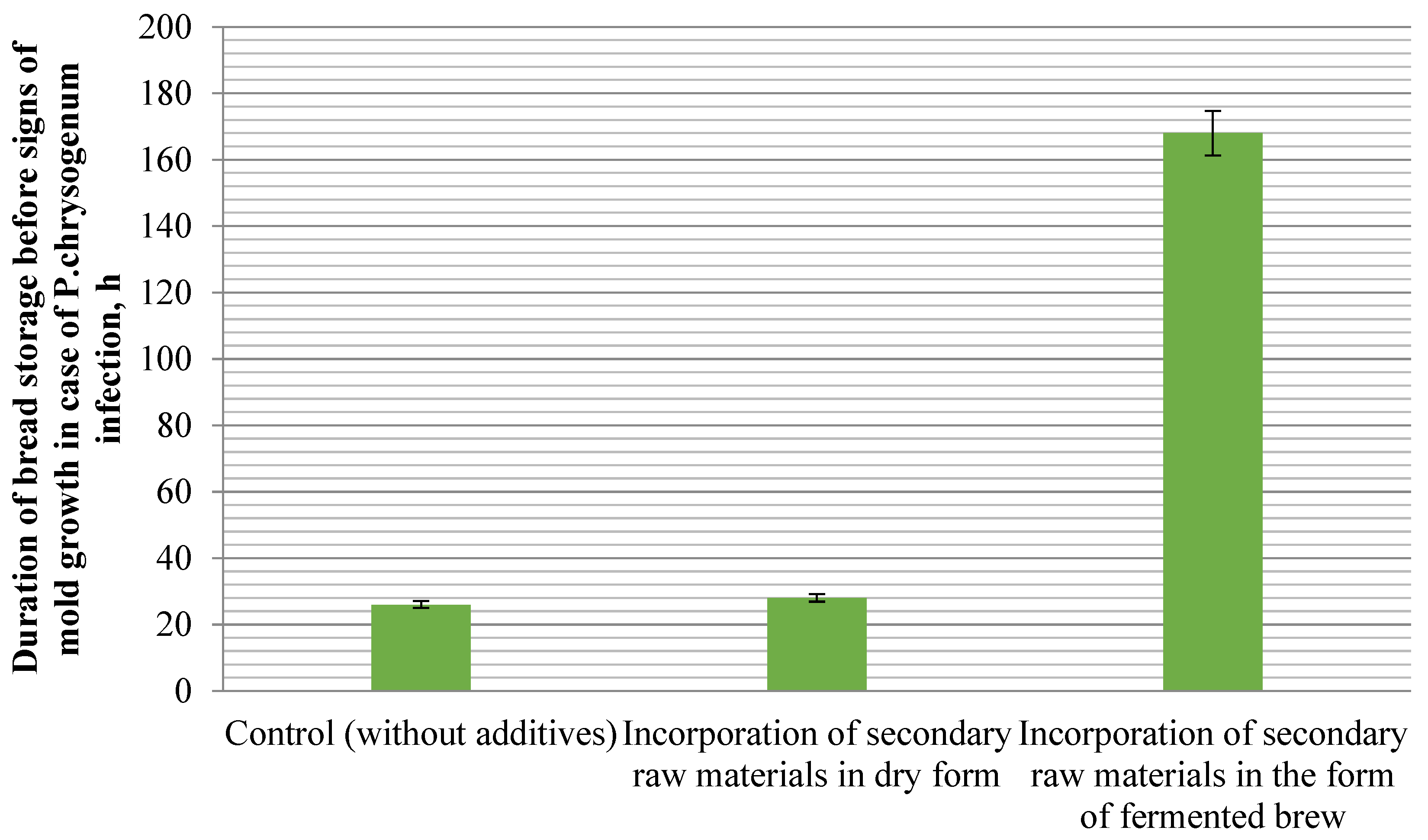
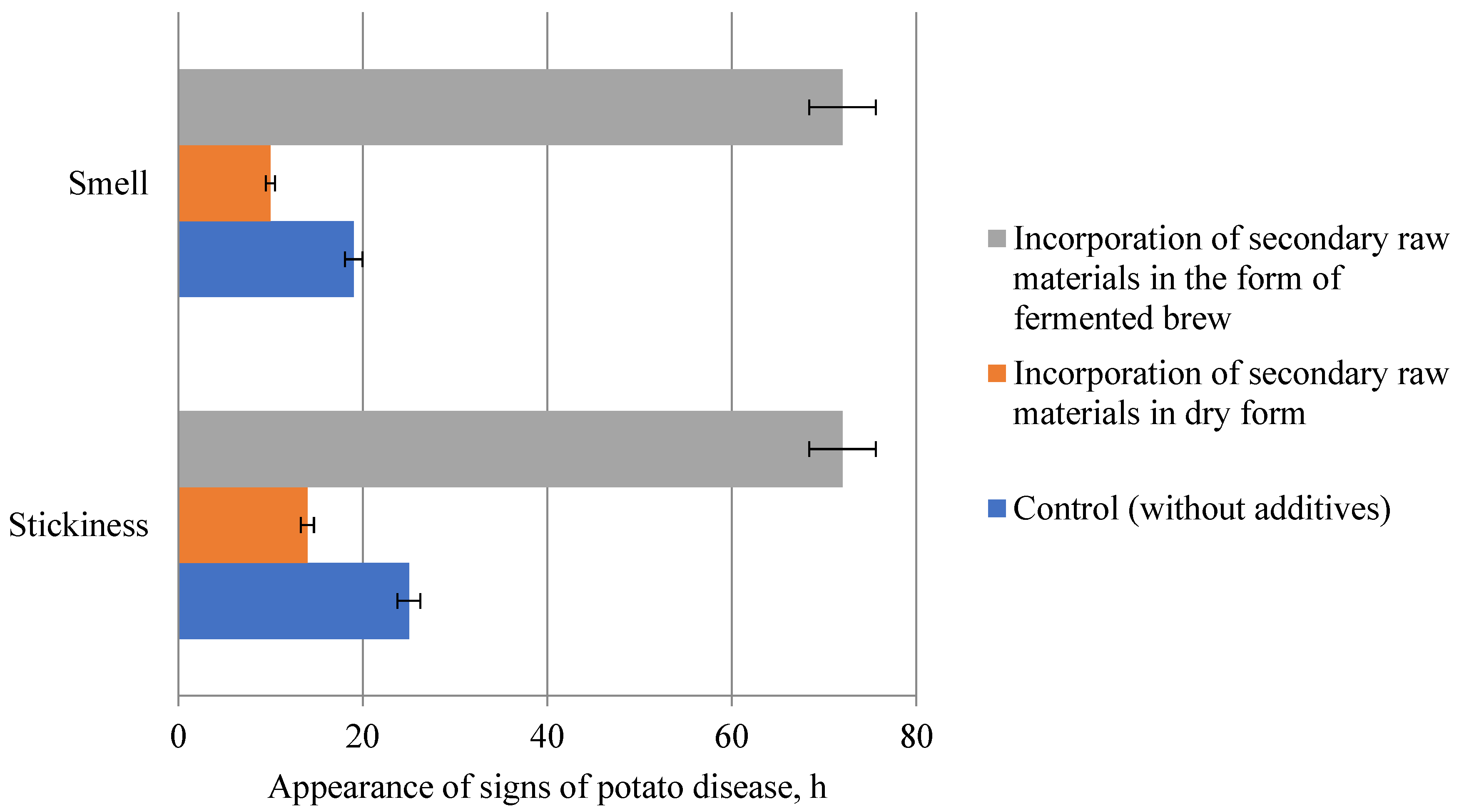
| Factors | Levels of Variation | Variation Intervals | |||||
|---|---|---|---|---|---|---|---|
| Natural | Encoding | −1.68 | −1 | 0 | +1 | +1.68 | |
| W, g | x1 | 273.2 | 280 | 290 | 300 | 306.8 | 10 |
| R, g | x2 | 6.5 | 10 | 15 | 20 | 23.4 | 5 |
| B, g | x3 | 16.6 | 20 | 25 | 30 | 33.4 | 5 |
| No. | Encoded Values | Natural Values | Experimental Values | ||||||
|---|---|---|---|---|---|---|---|---|---|
| x1 | x2 | x3 | W, g | R, g | B, g | Y1 | Y2 | Y3 | |
| 1 | - | - | - | 280 | 10 | 20 | |||
| 2 | - | - | + | 280 | 10 | 30 | |||
| 3 | - | + | - | 280 | 20 | 20 | |||
| 4 | - | + | + | 280 | 20 | 30 | |||
| 5 | + | - | - | 300 | 10 | 20 | |||
| 6 | + | - | + | 300 | 10 | 30 | |||
| 7 | + | + | - | 300 | 20 | 20 | |||
| 8 | + | + | + | 300 | 20 | 30 | |||
| 9 | −1.68 | 0 | 0 | 306.82 | 15 | 25 | |||
| 10 | +1.68 | 0 | 0 | 273.18 | 15 | 25 | |||
| 11 | 0 | −1.68 | 0 | 290 | 23.41 | 25 | |||
| 12 | 0 | +1.68 | 0 | 290 | 6.59 | 25 | |||
| 13 | 0 | 0 | −1.68 | 290 | 15 | 33.41 | |||
| 14 | 0 | 0 | +1.68 | 290 | 15 | 16.59 | |||
| 15 | 0 | 0 | 0 | 290 | 15 | 25 | |||
| 16 | 0 | 0 | 0 | 290 | 15 | 25 | |||
| 17 | 0 | 0 | 0 | 290 | 15 | 25 | |||
| 18 | 0 | 0 | 0 | 290 | 15 | 25 | |||
| 19 | 0 | 0 | 0 | 290 | 15 | 25 | |||
| 20 | 0 | 0 | 0 | 290 | 15 | 25 | |||
| No. | Encoded Values | Natural Values | Experimental Values | ||||||
|---|---|---|---|---|---|---|---|---|---|
| x1 | x2 | x3 | W, g | R, g | B, g | Y1 | Y2 | Y3 | |
| 1 | - | - | - | 280 | 10 | 20 | 352 | 60.1 | 18 |
| 2 | - | - | + | 280 | 10 | 30 | 320 | 59.9 | 16 |
| 3 | - | + | - | 280 | 20 | 20 | 305 | 58.2 | 15 |
| 4 | - | + | + | 280 | 20 | 30 | 295 | 58.8 | 14 |
| 5 | + | - | - | 300 | 10 | 20 | 310 | 60.4 | 15 |
| 6 | + | - | + | 300 | 10 | 30 | 339 | 60.5 | 16 |
| 7 | + | + | - | 300 | 20 | 20 | 198 | 59.9 | 15 |
| 8 | + | + | + | 300 | 20 | 30 | 300 | 60.8 | 17 |
| 9 | −1.68 | 0 | 0 | 306.82 | 15 | 25 | 320 | 61.3 | 14 |
| 10 | +1.68 | 0 | 0 | 273.18 | 15 | 25 | 283 | 60.4 | 16 |
| 11 | 0 | −1.68 | 0 | 290 | 23.41 | 25 | 275 | 57.8 | 12 |
| 12 | 0 | +1.68 | 0 | 290 | 6.59 | 25 | 335 | 61.4 | 14 |
| 13 | 0 | 0 | −1.68 | 290 | 15 | 33.41 | 306 | 61.1 | 17 |
| 14 | 0 | 0 | +1.68 | 290 | 15 | 16.59 | 325 | 59.1 | 14 |
| 15 | 0 | 0 | 0 | 290 | 15 | 25 | 275 | 61.1 | 15 |
| 16 | 0 | 0 | 0 | 290 | 15 | 25 | 280 | 61.0 | 15 |
| 17 | 0 | 0 | 0 | 290 | 15 | 25 | 278 | 61.2 | 15 |
| 18 | 0 | 0 | 0 | 290 | 15 | 25 | 282 | 61.1 | 15 |
| 19 | 0 | 0 | 0 | 290 | 15 | 25 | 277 | 61.1 | 15 |
| 20 | 0 | 0 | 0 | 290 | 15 | 25 | 280 | 61.2 | 15 |
| Name of Physicochemical Indicators of the Process | Meaning of Dough Values for Bread | ||
|---|---|---|---|
| Control (Without Additives) | With the Application of Rice and Buckwheat Brans in the Ratio of 5:10 | ||
| In the Dry State | In the Form of Fermented Brew | ||
| Humidity, % | 47.0 ± 1.0 | ||
| Temperature, °C | |||
| - initial | 29 ± 1 a | 30 ± 1 a | 29 ± 1 a |
| - final | 31 ± 1 a | 31 ± 1 a | 30 ± 1 a |
| Acidity, deg | |||
| - initial | 2.3 ± 0.5 a | 3.4 ± 0.5 b | 8.2 ± 1.0 c |
| - final | 2.6 ± 0.5 a | 4.5 ± 0.5 b | 9.0 ± 1.0 c |
| Fermentation duration, min | 60 ± 5 | ||
| Volume increase, % | 77.4 ± 0.1 a | 90 ± 0.1 b | 100 ± 0.1 c |
| Lifting force, min | 4 ± 1 a | 10 ± 1 b | 7 ± 1 c |
| Proofing time, min | 55 ± 5 a | 55 ± 5 a | 45 ± 5 b |
| Name of Process Indicators | Meaning of Bread Indicators | ||
|---|---|---|---|
| Control (Without Additives) | With Rice and Buckwheat Brans in the Ratio of 5:10 | ||
| In the Dry State | In the Form of Fermented Brew | ||
| Humidity, % | |||
| - whole bread | 41.2 ± 0.5 a | 41.3 ± 0.5 a | 42.4 ± 0.5 b |
| - crumb | 47.0 ± 0.5 a | 48.0 ± 0.5 b | 48.5 ± 0.5 c |
| Acidity, grad | 1.8 ± 0.1 a | 2.8 ± 0.1 b | 6.0 ± 0.5 c |
| Porosity, % | 78 ± 2 a | 78 ± 2 a | 73 ± 2 b |
| Specific volume, cm3/g | 2.96 ± 0.1 a | 2.96 ± 0.1 a | 2.51 ± 0.1 b |
| Alcohol content, % on dry substances | 0.48 ± 0.1 a | 0.51 ± 0.1 b | 0.96 ± 0.1 c |
| Volatile acid content | |||
| - hail | 0.70 ± 0.1 a | 0.8 ± 0.1 a | 2.05 ± 0.1 b |
| - % of total acidity | 38.9 ± 0.1 a | 28.6 ± 0.1 b | 34.2 ± 0.1 c |
| Sugar content | |||
| - % on dry substances | 4.32 ± 0.1 a | 4.14 ± 0.1 a | 3.10 ± 0.1 c |
| g per 100 g of product | 2.54 ± 0.1 a | 2.43 ± 0.1 a | 1.79 ± 0.1 b |
| Name of Process Indicators | Meaning of Bread Indicators | ||
|---|---|---|---|
| Control (Without Additives) | With Rice and Buckwheat Brans in the Ratio of 5:10 | ||
| In the Dry State | In the Form of Fermented Brew | ||
| Crumb moisture, % | |||
| after 24 h | 47.0 ± 1.0 a | 48.1 ± 1.0 b | 48.6 ± 1.0 c |
| after 48 h | 46.2 ± 1.0 a | 48.0 ± 1.0 b | 48.5 ± 1.0 c |
| after 72 h | 46.0 ± 1.0 a | 47.7 ± 1.0 b | 48.2 ± 1.0 c |
| Crumbliness, % | |||
| after 24 h | 4.15 ± 0.10 a | 1.88 ± 0.10 b | 1.66 ± 0.10 c |
| after 48 h | 4.48 ± 0.10 a | 3.43 ± 0.10 b | 3.83 ± 0.10 c |
| after 72 h | 7.15 ± 0.11 a | 6.10 ± 0.11 b | 4.38 ± 0.11 c |
| Physical properties of the crumb: hardness index, G/[(g/cm3)%] | |||
| after 24 h | 26.1 ± 0.1 a | 26.2 ± 0.1 a | 25.2 ± 0.1 b |
| after 48 h | 33.9 ± 0.2 a | 32.0 ± 0.1 b | 33.5 ± 0.1 c |
| after 72 h | 37.3 ± 0.2 a | 34.1 ± 0.1 b | 39.8 ± 0.2 c |
| Name of Indicators | Value of Indicators (g/100 g) of Bread | |
|---|---|---|
| Control (Without Additives) | Using Rice and Buckwheat Brans in the Form of Fermented Brew | |
| Protein, g | 8.17 ± 0.03 a | 12.97 ± 0.05 b |
| Fats, g | 0.99 ± 0.02 a | 6.0 ± 0.07 b |
| Carbohydrates, g | 44.35 ± 0.68 a | 33.46 ± 0.24 b |
| Dietary fiber, g | 2.63 ± 0.03 a | 2.85 ± 0.03 b |
| Vitamins. mg: | ||
| E | 1.3 ± 0.03 a | 0.768 ± 0.05 b |
| PP (niacin) | 0.42 ± 0.01 a | 0.279 ± 0.056 b |
| B2 (riboflavin) | 0.03 ± 0.01 a | 0.050 ± 0.021 b |
| B5 (pantothenic acid) | - | 0.074 ± 0.013 |
| B6 (pyridoxine) | - | 0.046 ± 0.009 |
| Mineral substances. mg: | ||
| Iron | 0.95 ± 0.08 a | 5.47 ± 0.05 b |
| Sodium | 381.71 ± 2.4 a | 355.19 ± 2.1 b |
| Magnesium | 12.54 ± 0.06 a | 75.78 ± 0.51 b |
| Calcium | 17.35 ± 0.25 a | 30.21 ± 0.06 b |
| Potassium | 94.84 ± 1.60 a | 268.93 ± 0.97 b |
| Phosphorus | 67.48 ± 1.53 a | 218.66 ± 1.05 b |
| Energy value. kcal | 219.0 ± 1.50 a | 239.72 ± 1.50 b |
| Name of Main Nutritional Substances | Daily Energy and Nutrient Requirements for Adults | Value of Indicators of Satisfaction of Daily Requirement in Nutrients When Consuming 250 g of Bread | |||
|---|---|---|---|---|---|
| Control (Without Additives) | Using Rice and Buckwheat Brans in the Form of Fermented Brew | ||||
| g | % | g | % | ||
| Protein. g | 104 | 20.4 | 19.6 | 32.4 | 31.2 |
| Fats. g | 100 | 2.5 | 2.5 | 15 | 15 |
| Carbohydrates. g | 360 | 110.9 | 30.8 | 83.6 | 23.2 |
| Dietary fiber. g | 38.6 | 6.6 | 17 | 7.1 | 18.4 |
| Vitamins. mg/: | |||||
| E | 26 | 3.3 | 12.7 | 1.9 | 7.3 |
| PP (niacin) | 18.6 | 1.0 | 5.4 | 0.7 | 3.8 |
| B2 (riboflavin) | 1.7 | 0.1 | 5.8 | 0.1 | 5.8 |
| B5 (pantothenic acid) | 10 | - | - | 0.2 | 2 |
| B6 (pyridoxine) | 2 | - | - | 0.1 | 5 |
| Minerals. mg/: | |||||
| Iron | 25 | 2.3 | 9.2 | 13.7 | 54.8 |
| Sodium | 2000 | 954.3 | 47.7 | 888.0 | 44.4 |
| Magnesium | 400 | 31.35 | 7.8 | 189.5 | 47.4 |
| Calcium | 957 | 43.4 | 4.5 | 75.5 | 7.9 |
| Potassium | 2500 | 237.1 | 9.5 | 672.3 | 26.9 |
| Phosphorus | 1000 | 168.7 | 16.87 | 546.7 | 54.7 |
Disclaimer/Publisher’s Note: The statements, opinions and data contained in all publications are solely those of the individual author(s) and contributor(s) and not of MDPI and/or the editor(s). MDPI and/or the editor(s) disclaim responsibility for any injury to people or property resulting from any ideas, methods, instructions or products referred to in the content. |
© 2024 by the authors. Licensee MDPI, Basel, Switzerland. This article is an open access article distributed under the terms and conditions of the Creative Commons Attribution (CC BY) license (https://creativecommons.org/licenses/by/4.0/).
Share and Cite
Yessembek, M.; Tarabayev, B.; Kakimov, M.; Gajdzik, B.; Wolniak, R.; Bembenek, M. Utilization of Secondary Raw Materials from Rice and Buckwheat Processing for the Production of Enriched Bread: Optimization of Formulation, Physicochemical and Organoleptic Properties, Structural and Mechanical Properties, and Microbiological Safety. Foods 2024, 13, 2678. https://doi.org/10.3390/foods13172678
Yessembek M, Tarabayev B, Kakimov M, Gajdzik B, Wolniak R, Bembenek M. Utilization of Secondary Raw Materials from Rice and Buckwheat Processing for the Production of Enriched Bread: Optimization of Formulation, Physicochemical and Organoleptic Properties, Structural and Mechanical Properties, and Microbiological Safety. Foods. 2024; 13(17):2678. https://doi.org/10.3390/foods13172678
Chicago/Turabian StyleYessembek, Madina, Baltash Tarabayev, Mukhtarbek Kakimov, Bożena Gajdzik, Radosław Wolniak, and Michał Bembenek. 2024. "Utilization of Secondary Raw Materials from Rice and Buckwheat Processing for the Production of Enriched Bread: Optimization of Formulation, Physicochemical and Organoleptic Properties, Structural and Mechanical Properties, and Microbiological Safety" Foods 13, no. 17: 2678. https://doi.org/10.3390/foods13172678
APA StyleYessembek, M., Tarabayev, B., Kakimov, M., Gajdzik, B., Wolniak, R., & Bembenek, M. (2024). Utilization of Secondary Raw Materials from Rice and Buckwheat Processing for the Production of Enriched Bread: Optimization of Formulation, Physicochemical and Organoleptic Properties, Structural and Mechanical Properties, and Microbiological Safety. Foods, 13(17), 2678. https://doi.org/10.3390/foods13172678











